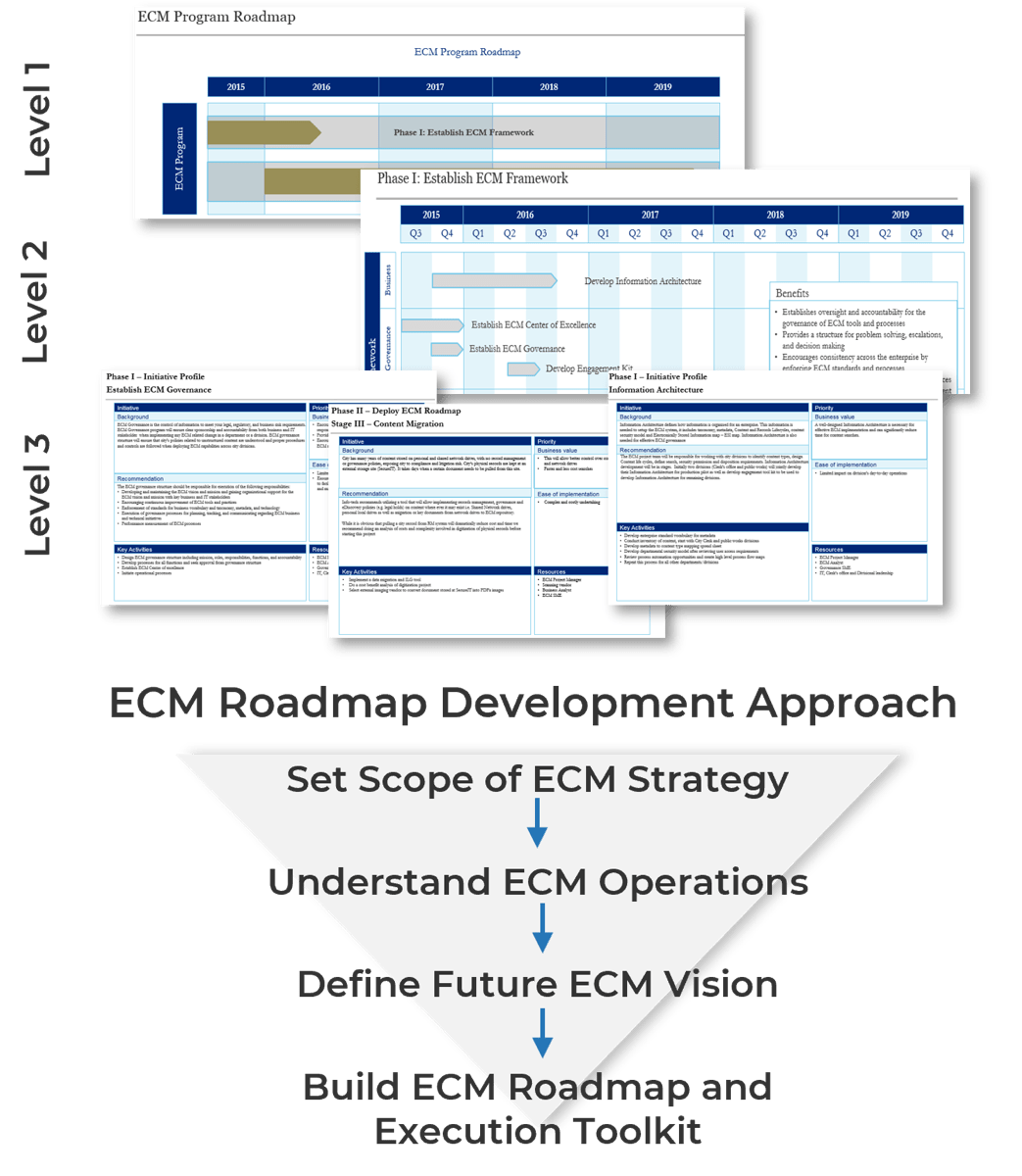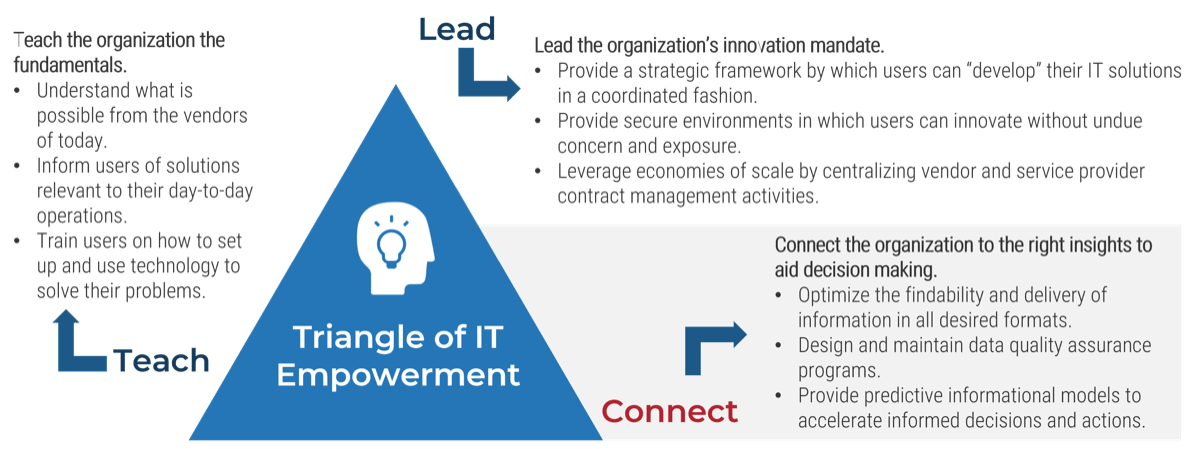Organizations face several content management challenges:
- Understanding and adhering to the right laws for your jurisdiction and industry.
- Optimizing contract processing workflows.
- Changing the culture from email and paper processing.
- Ensuring you have a records and information management and workflow foundation in place.
Our Advice
Critical Insight
- ECM is critical to organizational survival. ECM underpins effective information management, which is vital to surviving and thriving in the Digital Revolution.
- Engage many hands to make light work. Changing your ECM capabilities is about changing organizational behavior; take an all-hands-on-deck approach to make the most of information gathering, create a vested interest, and secure buy-in.
- ECM is a living, breathing thing. World-class ECM capabilities are not built overnight; be realistic about what you can achieve in this iteration based on your maturity.
- ECM is a business strategy, not an IT service. Modern content management is designed to be business driven and managed. Engage business users early and often in the ECM strategy and apply design thinking to the solution.
Impact and Result
- Establish a starting point and determine what is in scope for your ECM strategy to get the most value from your project.
- Conduct an operational assessment to find out what your people need.
- Create a roadmap that will bring your future-state ECM capability visions to life.
- Kick-start project execution with a comprehensive ECM roadmap execution toolkit.
- Empower your content managers and users with an understanding of best practices for being active information stewards.
Member Testimonials
After each Info-Tech experience, we ask our members to quantify the real-time savings, monetary impact, and project improvements our research helped them achieve. See our top member experiences for this blueprint and what our clients have to say.
8.6/10
Overall Impact
$171,705
Average $ Saved
31
Average Days Saved
Client
Experience
Impact
$ Saved
Days Saved
Southwest Gas Corporation
Workshop
8/10
$1.09M
120
The best part of the experience was having the support from an ECM expert and project manager specializing in ECM practices (Claudia). The worst pa... Read More
HANCOCK PROSPECTING PTY LIMITED
Guided Implementation
10/10
$22,500
2
Platinum Equity Advisors LLC
Guided Implementation
10/10
N/A
10
Having someone who works on these topics with a number of other companies either within my industry or outside. As a customer you can understand if... Read More
Vancouver Foundation
Guided Implementation
9/10
$17,500
20
Andrea was fantastic!!! The VF IT Team found the information around ECM extremely useful and we are excited on building on this first analyst sessi... Read More
Enable Ireland
Guided Implementation
10/10
$36,999
20
It was hard to complete the above estimates as we are at the start of the project. Best: Andrea is very professional and knowledgeable and had som... Read More
National Water Utility Service LLC
Workshop
6/10
$13,700
10
Best: tools provided were very detailed, breaks allotted, knowledgeable expert. Worst: time taken away from work duties, alignment with our expect... Read More
Waimakariri District Council
Guided Implementation
9/10
N/A
2
County of Inyo
Guided Implementation
8/10
$68,500
5
McLean County, IL
Guided Implementation
7/10
$13,700
50
The National Gas Company of Trinidad and Tobago Limited
Guided Implementation
8/10
$19,865
10
More time was needed to complete some of the discussion. Need more coordination with the NGC team to focus the discussion for each session so that ... Read More
TransAlta Corporation
Guided Implementation
9/10
$10,000
20
Worst: At the beginning the conversation was too high level Best: After we got aligned with the topic; the analyst provided excellent content.
Heritage Co-op 1997 Ltd.
Guided Implementation
10/10
$50,000
50
Jennison Associates
Guided Implementation
7/10
N/A
N/A
I was disappointed that they don't have anything on Microsoft Purview, since MSFT is a big player in this space.
The National Gas Company of Trinidad and Tobago Limited
Workshop
9/10
$548K
90
The best part of the experience was the expert facilitation provided by the very experienced and knowledgeable Info-Tech Research Group consultant ... Read More
University of Maribor
Guided Implementation
10/10
N/A
N/A
Clear communication, a prompt follow-up as promised.
Central Bank of Barbados
Workshop
9/10
$51,375
29
The best part was understanding the components of an ECM operational model. This was a bit daunting since we have quite a bit more implementation w... Read More
Town of Normal
Guided Implementation
6/10
$2,393
2
Andrea was very knowledgeable in the subject. However, her delivery style could not keep people interested for long. She sounded very academic. S... Read More
CAF - Corporacion Andina de Fomento
Guided Implementation
10/10
$18,269
9
Fidelity Investments Canada ULC
Guided Implementation
10/10
N/A
10
The conversation with Andrea was one of the best analyst calls we had with InfoTech, insightful, informative, and with exact actionable items for u... Read More
LION
Workshop
8/10
$31,499
50
Best part of the experience--better understanding of ECM activities and interdependencies; assistance in defining in/out of scope for immediate pro... Read More
CAF - Corporacion Andina de Fomento
Guided Implementation
10/10
$12,399
20
The call exceeded my expectations, we cover best practices, frameworks and above all real world examples!
Knights of Columbus
Workshop
9/10
N/A
14
informative, and a very collaborative team-day 1 should have included some type of ice breaker , since not all participants knew each other , very ... Read More
Trinidad / Benham Corporation
Guided Implementation
9/10
$58,899
10
ActivEdge Technologies Limited
Guided Implementation
8/10
$12,399
20
The presentation was detailed, interactive and contextually delivered to address the project requirements; with rich set of supportive tools and te... Read More
Mohawk Council of Kahnawake
Guided Implementation
9/10
$25,000
20
Good first contact and discussion. Team was engaged and mostly likely will continue to participate in future meetings.
Westoba Credit Union Limited
Workshop
8/10
$50,000
47
Best: Having structured templates and processes to follow. Worst: 4 days of a Teams session!
Dark Fibre Africa
Guided Implementation
10/10
N/A
N/A
Cross Country Mortgage, Inc.
Guided Implementation
10/10
$61,979
20
Very helpful. Many thanks.
Long Beach Transit
Guided Implementation
10/10
N/A
N/A
Igor's insights were valuable to me personally, as my knowledge of SharePoint is very little. Igor has shed lights on different approaches we'll be... Read More
ArcBest Technologies
Workshop
8/10
N/A
N/A
Workshop: Develop an Enterprise Content Management Strategy and Roadmap
Workshops offer an easy way to accelerate your project. If you are unable to do the project yourself, and a Guided Implementation isn't enough, we offer low-cost delivery of our project workshops. We take you through every phase of your project and ensure that you have a roadmap in place to complete your project successfully.
Module 1: Establish Business Context and Value
The Purpose
Understand the business opportunities and use cases.
Key Benefits Achieved
- Pinpoint the business opportunities for and scope of the ECM solution.
- Understand scenarios and stakeholders in key ECM use cases to inform decisions about the solution.
Activities
Outputs
Conduct use case analysis.
- ECM use cases
Conduct business capability mapping.
- Key business areas in scope
Identify the ECM vision and mission.
- ECM vision and mission statements
Module 2: Understand Current ECM Capabilities and Plot Target-State Levels
The Purpose
- Understand ECM operations.
- Understand current ECM capabilities and maturity: governance, information architecture, processes/workflows, systems architecture.
- Identify target-state ECM capabilities.
Key Benefits Achieved
- Define the flow of documents and information landscape. to identify opportunities
- Provide clear guidelines to users about appropriate use of technology.
- Create a map to plan and check integrations.
Activities
Outputs
Review and analyze the information management landscape.
- System landscape
Define where the files will originate and what the flow is (lifecycle).
- Guidelines about the location and flow of information.
Define the scope of the ECM strategy and project.
- ECM project charter with scope and RACI
Module 3: Plan ECM Work Initiatives
The Purpose
- Define work initiatives to achieve target state.
- Set metrics to measure success.
- Define governance and operating models.
Key Benefits Achieved
- Focus on and invest in most important capabilities for the most impact and ROI.
- Clear direction and metrics for success.
Activities
Outputs
Evaluate and prioritize performance gaps and opportunities.
- Target-state ECM initiatives
Develop and consolidate ECM target-state initiatives.
- Target-state ECM governance framework
Develop target-state ECM operating model.
- Target-state ECM operating model
Module 4: Formulate a Plan to Get to Your Target State
The Purpose
- Build initiatives into a plan with responsibilities and timing.
- Define immediate next steps.
Key Benefits Achieved
- Detailed action plan to execute ECM strategy.
- Valuable resources identified to assist in strategy execution.
Activities
Outputs
Identify and prioritize next steps.
- Initialized ECM strategy project roadmap
Define roles and responsibilities and complete a high-level RACI.
- Initialized RACI
Wrap up and discuss next steps and post-workshop support.
- Options for continued Info-Tech support
















 Right-Size the Governance Model for Your ECM Program
Right-Size the Governance Model for Your ECM Program
 Embrace Information Lifecycle Management in Your ECM Program
Embrace Information Lifecycle Management in Your ECM Program
 Develop an Enterprise Content Management Strategy and Roadmap
Develop an Enterprise Content Management Strategy and Roadmap
 Build a Digital Workspace Strategy
Build a Digital Workspace Strategy
 Effectively Use SharePoint as Your ECM Solution
Effectively Use SharePoint as Your ECM Solution
 Implement a Content Curator Playbook
Implement a Content Curator Playbook
 Adopting e-Signature
Adopting e-Signature
 Give Your Enterprise Content the Retail Experience: Use Retail Marketing Concepts to Design Intuitive ECM
Give Your Enterprise Content the Retail Experience: Use Retail Marketing Concepts to Design Intuitive ECM




